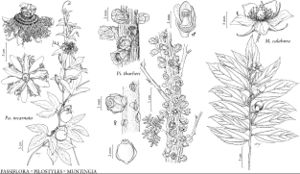Pilostyles
Ann. Sci. Nat., Bot., sér. 2, 2: 21, plate 1. 1834.
| Taxon | Illustrator ⠉ | |
|---|---|---|
 | Passiflora incarnata Pilostyles thurberi Muntingia calabura | Linny Heagy John Myers Linny Heagy |
Leaves reduced to imbricate bracts subtending flowers. Inflorescences solitary flowers produced endogenously and rupturing through host stems. Flowers with ringed nectary at base of sepals; sepals 4 or 5, free; stylar column expanded at apex into convex, knoblike disc, this sometimes fringed or papillose; staminate flowers with 1–3 series of anthers near column apex, under margin of disc; pistillate flowers with stigmatic areas in ring along or under margin of disc. Capsules irregularly dehiscent, perianth and column remaining essentially unchanged after flowering. Seeds 0.2–0.3 mm; embryos relatively undifferentiated.
Distribution
sw United States, Mexico, Central America, South America, sw Asia, Africa, Australia
Discussion
Species 9 or 10 (1 in the flora).
Only the flowers and bracts of Pilostyles are visible on the surface of the host stems. It is not known definitely whether species of this genus are monoecious or dioecious. They are parasitic on woody legumes (Fabaceae in the broad sense).
Selected References
None.